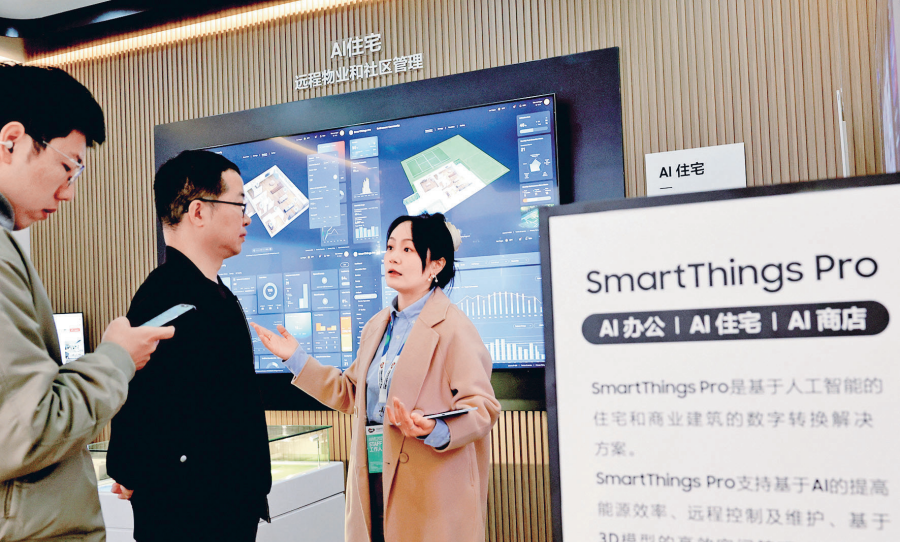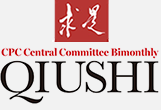Expanding Service Consumption Through a Multi-pronged Approach
During the Central Economic Work Conference held at the end of 2024, the need to “create a full range of new consumption scenarios and expand the scale of consumption” was highlighted. In March of 2025, the general offices of the Central Committee of the Communist Party of China (CPC) and the State Council jointly issued the Plan on Special Initiatives to Boost Consumption. This plan identified initiatives to upgrade service consumption and enhance people’s wellbeing as a key task for stimulating consumption.
I. The significance of expanding service consumption
Service consumption is, on one side, connected to the economy and, on the other, to the public wellbeing. It encompasses a wide range of sectors, including food and beverage, accommodation, domestic services, eldercare and childcare, cultural entertainment and tourism, education and sports, residential services, and health services. The expansion of service consumption thus holds both major immediate significance and long-term importance.
A key lever for vigorously boosting consumption and expanding overall domestic demand
Service consumption is characterized by its high frequency, strong multiplier effects, and sustainable growth. In 2024, China’s retail service sales grew by 6.2% year-on-year, outpacing retail goods sales by 3 percentage points. Per capita consumer spending on services increased by 7.4% year-on-year, accounting for 63% of the overall growth in per capita consumption expenditure. International trends suggest that when per capita GDP reaches approximately US$15,000, countries generally undergo an accelerated transition from goods-based to services-driven consumption. With China’s per capita GDP surpassing US$13,000, we are now entering a phase of rapid service consumption growth.

Visitors browse the foods on offer during the first day of a “Chinese Food Festival” event in Wuhan, Hubei Province, March 17, 2025. A Chinese food market and other specialty dining activities were held in conjunction with the event to boost consumption. PHOTO BY XINHUA REPORTER XIAO YIJIU
In 2024, service consumption constituted 46.1% of China’s total per capita consumer spending nationwide. Given the service consumption levels in developed economies, this suggests that China still enjoys considerable room for growth in this area. With the unlocking of further consumption potential, service consumption is poised to become a crucial engine of consumption growth both now and in the coming period.
An effective pathway for accelerating the shift to new growth drivers and promoting high-quality development
Due to its vast scope and strong multiplier effects, service consumption is an important force for optimizing supply, accelerating industrial upgrading, and facilitating the transition from old to new growth drivers. By expanding service consumption and leveraging the guiding role of demand, we can drive the growth of both consumer and producer services, thereby providing support for the development of new quality productive forces.
Since the mid-20th century, the value added of the service sector in developed economies has consistently accounted for over 60% of GDP. In countries like the United States, Japan, and Germany, it has hovered around 70%. In China, the value added of the service sector has averaged 54.6% of GDP over the past decade, indicating significant room for further growth. One example of this potential is the rising demand for information-based services—such as e-commerce, online education, and telemedicine—which can help spur rapid expansion and quality improvements in sectors like commerce, education, and healthcare. Boosting service consumption will help China stimulate both production and investment, eliminate supply and demand bottlenecks, and create a virtuous cycle where supply and demand reinforce each other and production and sales are in lockstep. All this will ensure we have the ongoing momentum needed to restructure industry and promote high-quality economic development.

A staff member (right) introduces AI residential solutions to visitors during the 2025 Appliance & Electronics World Expo (AWE2025) in Shanghai New International Expo Center. With the theme of “AI for All,” the AWE2025 kicked off on March 20, 2025. PHOTO BY XINHUA REPORTER FANG ZHE
An inherent requirement for improving living standards and meeting people’s aspirations for a better life
Adapting to evolving consumer demand means focusing less on the availability of goods and services and more on their quality. Service consumption in areas like eldercare, childcare, healthcare, cultural entertainment, and tourism is an integral part of daily life and directly affects the sense of fulfillment and happiness experienced by hundreds of millions of Chinese people. In 2024, China’s elderly population aged 60 and above reached 310 million, while the number of children under the age of 3 approached 30 million. Surveys indicate that over 30% of families with infants require childcare services. These trends have thus turned eldercare and childcare services into essential needs for many households.
At the same time, employment serves as the foundation of people’s wellbeing, and sectors such as food and beverage, accommodation, domestic services, commerce, tourism, culture, health, and fitness serve as crucial “employment reservoirs.” In 2023, China’s service sector accounted for 48.1% of total employment—19 and 25.3 percentage points higher than the secondary and primary industries, respectively. By expanding service consumption, we will be better placed to not only meet people’s more sophisticated and increasingly diverse needs for a better life, but also steadily expand employment channels, enhance employment flexibility, and increase workers’ incomes. The ultimate result of all this will be concrete improvements in people’s wellbeing.
A proactive measure to expand opening up and promote positive interplay between the Chinese and international economies
At present, the external environment is turning increasingly complex and severe. In the global economy, growth momentum is flagging, fragmentation is intensifying, and obstacles are impeding smooth economic flows. The expansion of China’s service consumption market is reliant on smooth flows in the domestic economy. But it is also contingent on further opening up to boost the supply of high-quality services and strengthen synergy with the international economy.
On one side, China has actively worked to attract inbound consumption. In 2024, the country registered 130 million international visits, marking a 60.8% increase from 2023. Total spending by international visitors for the year reached US$94.2 billion, up 77.8% year-on-year. On the other side, the expansion of service consumption has led to an increase in the service sector’s share of overall growth. This has helped attract more high-end international resources into China and facilitated the efficient flow and optimal allocation of resources within the service sector. The expansion of service consumption is thus both a cornerstone of our efforts to build a unified domestic market that is accessible to the world and an important example of how we are advancing reform and development through opening up. This approach will not only promote interplay between domestic and international economies but also accelerate the creation of a new development dynamic.
II. Favorable conditions for expanding service consumption
Following the start of the new era in 2012, China entered a stage of high-quality development, marked by deeper reform and opening up, improvements to the market system, and a steady rise in living standards. All this has laid a solid foundation for expanding service consumption.
Unlocking market potential has created new opportunities for the expansion of service consumption
With the adoption of robust and effective policy measures to build a strong domestic market, the potential for service consumption in China has become increasingly evident. Between 2013 and 2024, the per capita disposable income of Chinese residents rose from 18,000 yuan to 41,000 yuan, representing a growth of 126%. During the same period, per capita spending on services increased from 5,246 yuan to 13,000 yuan, an increase of 148%.
China is home to the world’s largest middle-income group, offering strong market potential and excellent prospects for growth. This is particularly true in such service sectors as eldercare, childcare, and healthcare, where vast untapped potential remains. At the same time, the pace of new urbanization is accelerating, with growing numbers of people from rural areas obtaining permanent urban residency. These shifts are stimulating new consumer demand in sectors such as education and training, cultural entertainment, and services related to housing. Between 2013 and 2024, the share of permanent urban residents in the total population rose from 53.7% to 67%. This figure will continue to rise into the future. According to estimates, each percentage-point increase in China’s permanent urban population generates approximately 200 billion yuan in new consumer demand annually, with around 100 billion yuan of this comprising demand for services.
Structural consumption upgrades have provided fresh momentum for the expansion of service consumption
As residents’ incomes have increased, we have witnessed rapid growth in the consumption of basic services in sectors such as food and beverage, accommodation, and domestic services. Between 2013 and 2024, nationwide revenues for food and beverage services grew from 2.5 trillion yuan to 5.6 trillion yuan, an increase of 119%. At the same time, changes in demographic structures and consumption attitudes have boosted spending on lifestyle improvements and new forms of consumption. Between 2013 and 2024, the share of total per capita spending on education and cultural entertainment rose from 10.6% to 11.3%, while healthcare spending increased from 6.9% to 9%. During the 2023–2024 winter season, China’s ice and snow leisure tourism sector registered 430 million visits, with total revenue hitting 524.7 billion yuan. In the 2024–2025 season, total visits are expected to reach 520 million, with revenue rising to 630 billion yuan.
Young people, and Gen Z in particular, demonstrate a greater willingness to spend money on personal interests and emotional values. They readily engage in consumption for personal pleasure and immersive experiences. The willingness of seniors to spend, meanwhile, also continues to rise, driving a boom in the silver economy. Additionally, demand for services targeting children, such as early education and non-curricular training, has surged, making these areas new service consumption hotspots.
Accelerated industrial development has generated new vitality for the expansion of service consumption
China’s service sector continues to grow in scale, as new forms and models of business flourish. Between 2013 and 2024, the added value of China’s service sector increased from 28.9 trillion yuan to 76.6 trillion yuan, and its share of economic growth rose from 48.2% to 56.2%. The results of China’s fifth national economic census indicate that the number and vitality of business entities engaged in tertiary industry activities have continued to surge. Over a five-year period, the number of legal entities increased by 9.22 million, an increase of 53.7%. Between 2013 and 2024, China’s internet penetration rate rose from 45.8% to 78.6%, while the number of mobile phone subscribers increased from 1.23 billion to 1.79 billion. In 2024, the number of mobile Internet of Things (IoT) terminal users reached 2.66 billion, while generative AI products attracted 250 million users.

Tourists enjoy the sight of blooming flowers at the Qianduo Scenic Area, Xinghua City, Jiangsu Province, April 5, 2025. During this year’s 3-day Qingming Festival holiday, China registered 126 million domestic trips, up 6.3% year-on-year, with total domestic tourism spending reaching about 57.55 billion yuan, up 6.7% year-on-year. XINHUA / PHOTO BY ZHOU SHEGEN
New technologies, such as mobile payments, the IoT, big data, artificial intelligence, and virtual reality, are being rapidly deployed across the service sector, creating a diverse range of consumption scenarios and profoundly transforming the habits and behaviors of consumers. These developments are steadily driving trends of digitalization, smart development, experience-based consumption, instantaneous service delivery, and integrated solutions in the service sector, generating new vitality for the expansion of service consumption.
III. Key tasks for expanding service consumption
Strengthening policy support
Leveraging the coordination mechanism for promoting service consumption, we will refine the “1+N” policy framework to effectively transform high-value policies into the tangible expansion of service consumption. Under this framework, “1” refers to the State Council’s Guidelines on Boosting High-Quality Development of Service Consumption. These guidelines represent China’s first comprehensive and systematic plan for service consumption development. “N,” meanwhile, refers to the various policy measures focusing on key industries and sectors introduced by various departments. We will mount a strong push to ensure that all policies are implemented. We will work with various departments and local authorities to effectively act on the guidelines on service consumption development and ensure that existing policies on initiatives such as the promotion of eldercare service consumption, specialized rail services catering to older travelers, and support for the development of public-benefit childcare services, are implemented and take root.
The Ministry of Commerce will take the lead in implementing initiatives to upgrade service consumption and benefit the public, refining specific measures in order to help effectively boost consumption. We will move faster to introduce new policies, issuing policy documents to support spending on domestic services and develop digital consumption. We will also work with relevant departments to formulate supporting policies for tourism, ultra-high-definition technology, the sports event economy, and traditional Chinese medicine healthcare. Further steps will be taken to study and develop fiscal, tax, and financial support policies, with a view to putting forward targeted and practical measures. In addition, we will actively respond to public expectations by addressing weaknesses affecting the expansion of service consumption, moving promptly to look into new support measures, and effectively developing a reserve of policy options.
Boosting the supply of high-quality services
We will actively adapt to structural upgrading trends in consumption by boosting the supply of high quality services. To this end, we will, on the condition that basic public services are effectively maintained, give full rein to the power of the market by opening wider to the world and easing regulations within China. To expand opening up in the service sector, we will steadily advance comprehensive pilot programs for this purpose and promote wider opening in cyberspace, culture, and other sectors. We will also expand pilot programs for opening up in the telecommunications, healthcare, and education sectors.
We will expand the catalog of encouraged industries for foreign investment to include service categories such as camping, homestays, property management services, and Internet Plus Healthcare initiatives. We will also expand imports of high-quality lifestyle services. To boost inbound consumption, we will introduce more premium tourism routes and services for foreign visitors and foster internationally oriented markets in the areas of education, healthcare, and conventions and exhibitions. We will accelerate regulatory easing within China, taking measures to widen market access, reduce restrictions, and optimize regulatory oversight. These steps will promote market competition, energize business entities of all types, and expand the diversified supply of services in areas such as healthcare, eldercare, childcare, and domestic services, so as to better meet the public’s consumption needs.
Developing a rich range of platforms
Adapting to the trend of digital, green, and high-quality development, we will enhance the online and offline integration of services, promote the integrated development of different forms of business, and foster a sound consumption environment to provide stronger support for the expansion of service consumption.
We will expand the scope of consumption promotion initiatives. In doing so, we will focus on key areas that are closely tied to people’s daily lives, have high demand potential, and are capable of creating strong spillover effects. We will enable the competent authorities in various industries to leverage their strengths and encourage different regions to harness their unique features, in order to jointly launch a series of “service consumption season” initiatives. The goal of these efforts will be to generate waves of consumption booms in the service sector. We will continue to organize a host of “Chinese Food Festival” initiatives to drive food and beverage consumption, promote consumption during China’s ice and snow leisure season, and make efforts to encourage service consumption as part of our online consumption promotion campaigns.
We will create new consumption scenarios. We will develop new settings, such as smart commercial districts, smart streets, and smart stores, and support the development of e-sports and social commerce. We will promote the renovation and upgrading of pedestrian streets, accelerate the construction of 15-minute urban living circles, and guide traditional shopping malls and supermarkets in developing leisure, entertainment, cultural, and fashion offerings for consumers. We will support historical and cultural cities in tapping into their traditional heritage to advance the integrated development of commerce, tourism, culture, sports, and health, and create more best practices for the development of innovative service consumption scenarios.
Enhancing the consumer environment
We are focused on ensuring people can consume with trust, ease, and delight. To maintain proper market order, we will beef up oversight of service consumption and promote sustainable development of the service consumption sector. We will provide guidance for businesses on conducting honest and compliant operations, and work together with relevant departments to organize an “Integrity in Business Promotion Month.” We will help relevant departments enhance their capacity for service quality monitoring and evaluation, and roll out service quality monitoring and evaluation systems. We will also launch service quality commitment initiatives and promote the development of credit systems in sectors such as household services.
To protect consumers, legitimate rights and interests, we will strengthen cross-departmental supervision and crack down on false advertising, online fraud, and consumer data leaks. We will ensure the channels for consumer complaints and rights protection operate smoothly. We will encourage communities, shopping centers, tourist attractions, and platform enterprises to establish consumer rights protection service stations, so as to promote the resolution of consumer disputes at their source.
Strengthening support systems
We will further improve relevant support systems and reinforce the foundations for service consumption development. To establish stronger standards, we will improve the standards system and cultivate standardized brands in the service sector. Additionally, we will formulate or revise service consumption-related standards in areas such as food and beverage, accommodation, domestic services, eldercare, childcare, cultural entertainment, tourism, home furnishing, decoration, and business services. We will also develop standards for new consumption forms, such as digital, green, and health consumption. The certification system in the service sector will also be enhanced.
To ensure better statistical monitoring, we will encourage relevant departments to optimize their monitoring methods for service consumption markets and refine their statistical monitoring systems. We will step up efforts to collect and analyze service consumption data and compile quality statistics for service retail sales. We will expand the scope of statistical data sources that we monitor and improve departmental data sharing. Cooperation with third-party payment platforms and research institutions will also be intensified to ensure service consumption development trends are fully reflected.
Wang Wentao is Minister and Secretary of the CPC Leadership Group, Ministry of Commerce
(Originally appeared in Qiushi Journal, Chinese edition, No. 8, 2025)
























